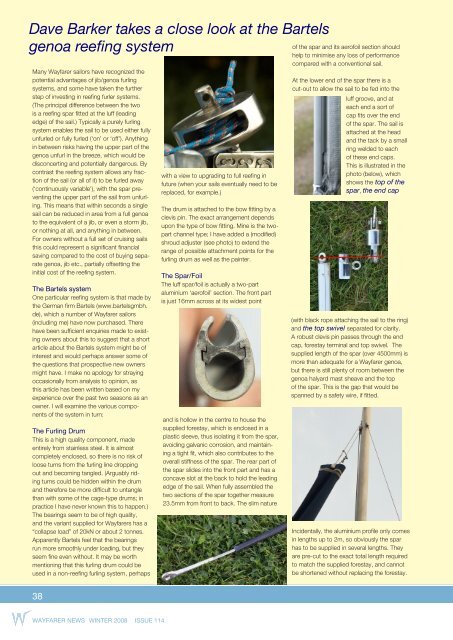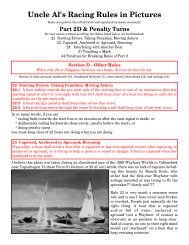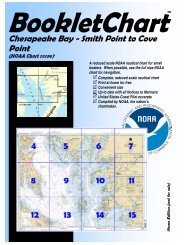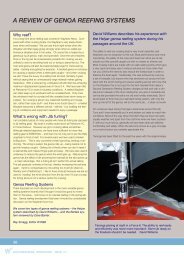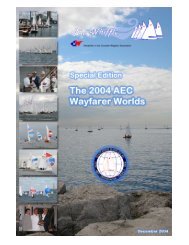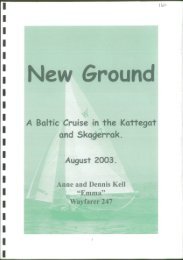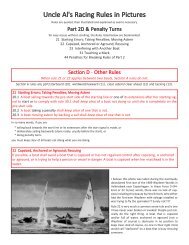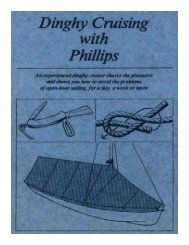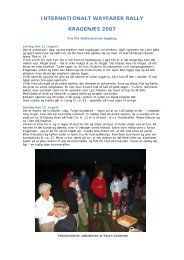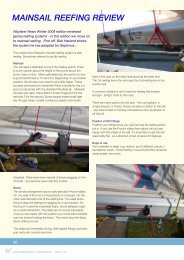Dave Barker explains the Bartels genoa furling/reefing system
Dave Barker explains the Bartels genoa furling/reefing system
Dave Barker explains the Bartels genoa furling/reefing system
- No tags were found...
Create successful ePaper yourself
Turn your PDF publications into a flip-book with our unique Google optimized e-Paper software.
<strong>Dave</strong> <strong>Barker</strong> takes a close look at <strong>the</strong> <strong>Bartels</strong><strong>genoa</strong> <strong>reefing</strong> <strong>system</strong>Many Wayfarer sailors have recognized <strong>the</strong>potential advantages of jib/<strong>genoa</strong> <strong>furling</strong><strong>system</strong>s, and some have taken <strong>the</strong> fur<strong>the</strong>rstep of investing in <strong>reefing</strong> furler <strong>system</strong>s.(The principal difference between <strong>the</strong> twois a <strong>reefing</strong> spar fitted at <strong>the</strong> luff (leadingedge) of <strong>the</strong> sail.) Typically a purely <strong>furling</strong><strong>system</strong> enables <strong>the</strong> sail to be used ei<strong>the</strong>r fullyunfurled or fully furled (‘on’ or ‘off’). Anythingin between risks having <strong>the</strong> upper part of <strong>the</strong><strong>genoa</strong> unfurl in <strong>the</strong> breeze, which would bedisconcerting and potentially dangerous. Bycontrast <strong>the</strong> <strong>reefing</strong> <strong>system</strong> allows any fractionof <strong>the</strong> sail (or all of it) to be furled away(‘continuously variable’), with <strong>the</strong> spar preventing<strong>the</strong> upper part of <strong>the</strong> sail from un<strong>furling</strong>.This means that within seconds a singlesail can be reduced in area from a full <strong>genoa</strong>to <strong>the</strong> equivalent of a jib, or even a storm jib,or nothing at all, and anything in between.For owners without a full set of cruising sailsthis could represent a significant financialsaving compared to <strong>the</strong> cost of buying separate<strong>genoa</strong>, jib etc., partially offsetting <strong>the</strong>initial cost of <strong>the</strong> <strong>reefing</strong> <strong>system</strong>.The <strong>Bartels</strong> <strong>system</strong>One particular <strong>reefing</strong> <strong>system</strong> is that made by<strong>the</strong> German firm <strong>Bartels</strong> (www.bartelsgmbh.de), which a number of Wayfarer sailors(including me) have now purchased. Therehave been sufficient enquiries made to existingowners about this to suggest that a shortarticle about <strong>the</strong> <strong>Bartels</strong> <strong>system</strong> might be ofinterest and would perhaps answer some of<strong>the</strong> questions that prospective new ownersmight have. I make no apology for strayingoccasionally from analysis to opinion, asthis article has been written based on myexperience over <strong>the</strong> past two seasons as anowner. I will examine <strong>the</strong> various componentsof <strong>the</strong> <strong>system</strong> in turn:The Furling DrumThis is a high quality component, madeentirely from stainless steel. It is almostcompletely enclosed, so <strong>the</strong>re is no risk ofloose turns from <strong>the</strong> <strong>furling</strong> line droppingout and becoming tangled. (Arguably ridingturns could be hidden within <strong>the</strong> drumand <strong>the</strong>refore be more difficult to untanglethan with some of <strong>the</strong> cage-type drums; inpractice I have never known this to happen.)The bearings seem to be of high quality,and <strong>the</strong> variant supplied for Wayfarers has a“collapse load” of 20kN or about 2 tonnes.Apparently <strong>Bartels</strong> feel that <strong>the</strong> bearingsrun more smoothly under loading, but <strong>the</strong>yseem fine even without. It may be worthmentioning that this <strong>furling</strong> drum could beused in a non-<strong>reefing</strong> <strong>furling</strong> <strong>system</strong>, perhapswith a view to upgrading to full <strong>reefing</strong> infuture (when your sails eventually need to bereplaced, for example.)The drum is attached to <strong>the</strong> bow fitting by aclevis pin. The exact arrangement dependsupon <strong>the</strong> type of bow fitting. Mine is <strong>the</strong> twopartchannel type; I have added a (modified)shroud adjuster (see photo) to extend <strong>the</strong>range of possible attachment points for <strong>the</strong><strong>furling</strong> drum as well as <strong>the</strong> painter.The Spar/FoilThe luff spar/foil is actually a two-partaluminium ‘aerofoil’ section. The front partis just 16mm across at its widest pointand is hollow in <strong>the</strong> centre to house <strong>the</strong>supplied forestay, which is enclosed in aplastic sleeve, thus isolating it from <strong>the</strong> spar,avoiding galvanic corrosion, and maintaininga tight fit, which also contributes to <strong>the</strong>overall stiffness of <strong>the</strong> spar. The rear part of<strong>the</strong> spar slides into <strong>the</strong> front part and has aconcave slot at <strong>the</strong> back to hold <strong>the</strong> leadingedge of <strong>the</strong> sail. When fully assembled <strong>the</strong>two sections of <strong>the</strong> spar toge<strong>the</strong>r measure23.5mm from front to back. The slim natureof <strong>the</strong> spar and its aerofoil section shouldhelp to minimise any loss of performancecompared with a conventional sail.At <strong>the</strong> lower end of <strong>the</strong> spar <strong>the</strong>re is acut-out to allow <strong>the</strong> sail to be fed into <strong>the</strong>luff groove, and ateach end a sort ofcap fits over <strong>the</strong> endof <strong>the</strong> spar. The sail isattached at <strong>the</strong> headand <strong>the</strong> tack by a smallring welded to eachof <strong>the</strong>se end caps.This is illustrated in <strong>the</strong>photo (below), whichshows <strong>the</strong> top of <strong>the</strong>spar, <strong>the</strong> end cap(with black rope attaching <strong>the</strong> sail to <strong>the</strong> ring)and <strong>the</strong> top swivel separated for clarity.A robust clevis pin passes through <strong>the</strong> endcap, forestay terminal and top swivel. Thesupplied length of <strong>the</strong> spar (over 4500mm) ismore than adequate for a Wayfarer <strong>genoa</strong>,but <strong>the</strong>re is still plenty of room between <strong>the</strong><strong>genoa</strong> halyard mast sheave and <strong>the</strong> topof <strong>the</strong> spar. This is <strong>the</strong> gap that would bespanned by a safety wire, if fitted.Incidentally, <strong>the</strong> aluminium profile only comesin lengths up to 2m, so obviously <strong>the</strong> sparhas to be supplied in several lengths. Theyare pre-cut to <strong>the</strong> exact total length requiredto match <strong>the</strong> supplied forestay, and cannotbe shortened without replacing <strong>the</strong> forestay.38wayfarer news WINTER 2008 ISSUE 114
The Top SwivelAgain this is a high quality component, withsmooth running bearings (even without loadin my experience) and a ‘collapse load’equivalent to <strong>the</strong> drum, i.e. 20kN. The swivelfits between <strong>the</strong> top of <strong>the</strong> spar and <strong>the</strong> endof <strong>the</strong> <strong>genoa</strong> halyard, and has a generoussizedoval ring to which <strong>the</strong> halyard can beattached with a shackle etc. in <strong>the</strong> usualway. (The swivel allows <strong>the</strong> sail to be furledor unfurled without introducing twists intoO<strong>the</strong>r factors to discuss with your sailmakerinclude:-1. Compensating for <strong>the</strong> unusually high tackposition caused by <strong>the</strong> <strong>furling</strong> drum.2. A shaped lightweight foam insert sewn behind<strong>the</strong> bolt rope to help take up <strong>the</strong> fullnessfrom <strong>the</strong> middle of <strong>the</strong> sail when it is partlyor fully furled. I decided to try such an insertand duly specified this when getting a new<strong>genoa</strong> made, but it has not been a total suc<strong>the</strong>halyard.) A good quality swivel is importantin any <strong>furling</strong> or <strong>reefing</strong> <strong>system</strong>, butsome of <strong>the</strong> cheaper versions are not reallyup to <strong>the</strong> job and tend not to work properlyunder load. This one is engineered to workwell under load, and does so. As with <strong>the</strong>drum, <strong>the</strong> swivel supplied in this <strong>system</strong>could be used as part of a non-<strong>reefing</strong><strong>furling</strong> <strong>system</strong> with a view to a subsequentupgrade.The ForestayArguably one of <strong>the</strong> biggest advantagesof this sort of <strong>system</strong> is <strong>the</strong> fact that <strong>the</strong>forestay is enclosed by <strong>the</strong> luff spar (asdiscussed previously). This removes asignificant potential cause of frustration,namely <strong>the</strong> tendency for <strong>the</strong> foresail tobecome wrapped around <strong>the</strong> (separate)forestay when <strong>furling</strong> <strong>the</strong> sail. A numberof well-publicised techniques have beendeveloped down <strong>the</strong> years to minimise thisrisk, but surely none is more effective thancompletely enclosing <strong>the</strong> stay.Seasoned cruisers will already have spotted<strong>the</strong> possible flaw in this argument,namely <strong>the</strong> absence of a separate forestayshould anything unfortunate happen to <strong>the</strong>drum, <strong>the</strong> enclosed stay, swivel, shackle orhalyard. However I should mention at thispoint that <strong>the</strong> wire used for <strong>the</strong> forestayis 4mm in diameter ra<strong>the</strong>r than <strong>the</strong> 3mmkind normally used as Wayfarer <strong>genoa</strong> luffwire, so <strong>the</strong> cross-sectional area is almostdouble that of <strong>the</strong> usual stay wire. This, and<strong>the</strong> high specification of <strong>the</strong> drum and swivel,significantly reduces <strong>the</strong> chance of failure, soit could be argued that <strong>the</strong>re is no need for aseparate stay.The halyard, however, is more vulnerable,and not just to <strong>the</strong> possibility of breakage;<strong>the</strong>re is also <strong>the</strong> potential for it to be releasedaccidentally or absent-mindedly, so a ‘safetywire’ between (say) <strong>the</strong> forestay attachmentpoint on <strong>the</strong> mast and <strong>the</strong> oval ring on <strong>the</strong>top swivel has been proposed as a sensibleprecaution. If <strong>the</strong> spinnaker halyard is notrequired while sailing this could take <strong>the</strong>place of <strong>the</strong> safety wire, and has <strong>the</strong> advantagethat it can be adjusted or even releasedwithout taking <strong>the</strong> mast down. Better stilla dedicated halyard would have <strong>the</strong> sameadvantages and would leave <strong>the</strong> spinnakerhalyard free for <strong>the</strong> spinnaker, whilst afloat,and for hoisting a <strong>genoa</strong> UV cover when notafloat. Some may feel that <strong>the</strong>re is no need toworry about a backup of any sort; after all werely on just one shroud on each side of <strong>the</strong>boat, with no backup. This is <strong>the</strong> sort of decisionthat has to be made individually by eachowner, taking into account <strong>the</strong> sort of sailingundertaken and <strong>the</strong> possible consequencesof gear failure.[The remaining components are not suppliedby <strong>Bartels</strong>, but for our purposes need to beconsidered as part of <strong>the</strong> same <strong>system</strong>:The SailAs mentioned, <strong>the</strong> <strong>genoa</strong> fits onto <strong>the</strong> sparby means of a concave groove in <strong>the</strong> back of<strong>the</strong> aluminium section. The sail needs to havea luff rope (bolt rope) of suitable diametersewn into <strong>the</strong> leading edge ra<strong>the</strong>r than <strong>the</strong>usual luff wire. The groove has a maximumdiameter of 5mm within <strong>the</strong> extrusion, whichdictates <strong>the</strong> bolt rope diameter, (not forgettingto allow for <strong>the</strong> thickness of <strong>the</strong> sailclotharound it). A good sailmaker will be able toconvert an existing sail, although this maynot furl as neatly as one designed for <strong>the</strong>purpose; this is because <strong>the</strong> standard sail islikely to be cut too ‘full’ to roll neatly around<strong>the</strong> spar, free from creases. A purpose-madesail can be cut flatter than usual, and canhave <strong>the</strong> o<strong>the</strong>r modifications to <strong>the</strong> head andtack, such as <strong>the</strong> addition of tape loops (below)or cringles for sail attachment ‘designedin’ from <strong>the</strong> start.I originally requested cringles for attaching<strong>the</strong> sail to <strong>the</strong> spar, but <strong>the</strong> sailmaker (MikeMcNamara) was very reluctant to use thismethod, preferring to use tape loops (mainlybecause <strong>the</strong>y are flexible, I think). Because Ileave <strong>the</strong> sail on <strong>the</strong> spar virtually all <strong>the</strong> time,this works well. The lower tape loop is tiedclosely to <strong>the</strong> lower end cap ring, with strong2- 3mm line. The upper loop (at <strong>the</strong> headof <strong>the</strong> sail) is attached to <strong>the</strong> upper end capring, and pulled just tight enough to take <strong>the</strong>slack out of <strong>the</strong> sail’s luff without introducingany vertical creases, before being tied off. IfI wanted to adjust <strong>the</strong> luff tension regularly,it would be necessary to shorten <strong>the</strong> uppertie a little to leave room for this adjustmentat <strong>the</strong> lower luff. (It is important to rememberthat luff tension and rig tension are entirelyseparate parameters.)An alternative method (which I would guesswould work better with cringles than tapeloops) would be to fix <strong>the</strong> lower luff (tack) anduse a halyard passing through <strong>the</strong> upper endcap ring to raise <strong>the</strong> sail and maintain/adjust<strong>the</strong> luff tension. This would have <strong>the</strong> advantageof ease of adjustment, and would makeit possible to remove <strong>the</strong> sail independentlyof <strong>the</strong> spar, even afloat if necessary, making<strong>the</strong> sail potentially available as a trysail, asdescribed elsewhere. (This kind of <strong>genoa</strong> isparticularly suitable as a trysail because italready has a luff/bolt rope, which can be slidinto <strong>the</strong> mast groove.)39Find all <strong>the</strong> latest news at www.wayfarer.org.uk
cess, having taken on a permanent curveacross its width (from being furled away in<strong>the</strong> same direction for so much of <strong>the</strong> time).This disrupts <strong>the</strong> airflow just behind <strong>the</strong> luff,particularly on port tack, and makes <strong>the</strong> telltalesappear to lift more or less constantly.(It would be simple enough to remove <strong>the</strong>foam – it’s held in place by a sort of ‘blister’or patch of extra sailcloth (below), whichcould be unpicked and removed.) Thisproblem seems to relate to certain types offoam, as o<strong>the</strong>rs have reported no curvature,even after several years.The Sail CoverIf you are likely to leave <strong>the</strong> <strong>genoa</strong> and sparrigged on <strong>the</strong> boat for more than a fewdays it is important to protect <strong>the</strong> exposedparts of <strong>the</strong> sail from UV and wind damage.I suppose it would be possible to have asacrificial strip fitted to <strong>the</strong> leech as is often<strong>the</strong> case with yachts, but this fairly quicklystarts to become tatty, and is still visiblewhen sailing <strong>the</strong> boat. A separate cover canbe hoisted into position using <strong>the</strong> spinnakerhalyard (as mentioned previously), and willideally be made from a breathable materialsimilar to some types of boat cover. The sailcover doesn’t need to be much more than along tube with ei<strong>the</strong>r a full-length zip or velcroto enable it to be fitted around <strong>the</strong> furledsail in situ. If using a zip remember to attach<strong>the</strong> cover with <strong>the</strong> zip closing downwards!My cover has three webbing straps (white inphoto) around its girth, one at each end andone in <strong>the</strong> middle. There also needs to bea means of attaching <strong>the</strong> halyard at <strong>the</strong> topand a tie-down at <strong>the</strong> bottom.A good sailmaker should be able to makesuch a sail cover for a very reasonable price.I recommend dark blue as it doesn’t show<strong>the</strong> dirt!Transporting & handling <strong>the</strong> sparWhen not fitted to <strong>the</strong> boat <strong>the</strong> spar isslightly vulnerable to damage. Although itis much stronger than it looks it could fairlyeasily be distorted if subjected to careless oraccidental force. I carry mine strapped tightlyunder <strong>the</strong> mast when trailing <strong>the</strong> boat.I prefer to leave <strong>the</strong> <strong>genoa</strong> on <strong>the</strong> spar tominimise <strong>the</strong> number of times <strong>the</strong> sail is slidin and out of <strong>the</strong> luff groove. The disadvantageof this is <strong>the</strong> slight curl which <strong>the</strong> sail(and foam strip, as discussed) acquires overtime. I use <strong>the</strong> sail cover to protect <strong>the</strong> sailwhen trailing; if nothing else it helps to keep<strong>the</strong> sail clean. The <strong>furling</strong> drum can remainon <strong>the</strong> bow fitting, and it’s <strong>the</strong>n an easy jobto re-fit <strong>the</strong> spar once <strong>the</strong> mast has beenraised. (If using a safety wire to <strong>the</strong> mast’sforestay attachment ring this needs to berigged before raising <strong>the</strong> mast.)Unfortunately I have no personal experienceof bridge-shooting with a <strong>reefing</strong> spar, so Idon’t feel able to comment on possible solutionsto this problem, o<strong>the</strong>r than to say that<strong>the</strong> <strong>furling</strong> drum on Cockle has insufficientclearance below it to allow <strong>the</strong> mast to belowered with <strong>the</strong> drum in situ. Ano<strong>the</strong>r situationin which <strong>the</strong> spar might be vulnerableto damage is during recovery from a capsize- specifically when righting <strong>the</strong> boat followingpartial or complete inversion by pulling up<strong>the</strong> forestay. This is a well established rescuetechnique for power boat crews, but notkind to <strong>furling</strong> spars. Perhaps mast-headbuoyancy is <strong>the</strong> answer?Cost of <strong>the</strong> <strong>system</strong>The <strong>Bartels</strong> <strong>reefing</strong> <strong>system</strong> is well made, withhigh quality components, and in <strong>the</strong> opinionof several well-known cruising Wayfarers haskey advantages over its rivals, notably <strong>the</strong>robust stainless steel drum and top swivel,quality bearings and slender (but stiff) luffspar. All this comes at a price, and this is byno means one of <strong>the</strong> cheaper <strong>system</strong>s on<strong>the</strong> market. (The actual cost is approximatelyequivalent to that of a good new mainsail.)For anyone who has already invested in aconventional set of sails (<strong>genoa</strong>, jib, stormjib) it may be difficult to justify spending thismuch on a <strong>reefing</strong> <strong>system</strong>, although as mentionedit is possible to modify a conventional<strong>genoa</strong>. I would certainly recommend thatanyone who already has a conventional setof foresails and is contemplating installing a<strong>furling</strong>-only <strong>system</strong> should at least considerselecting components that can form <strong>the</strong>basis of a full <strong>reefing</strong> <strong>system</strong>.If starting from scratch <strong>the</strong> economics areslightly different, as <strong>the</strong> <strong>reefing</strong> <strong>system</strong> in effecttakes <strong>the</strong> place of a jib and a storm jib (3sails for <strong>the</strong> price of 1), and avoids <strong>the</strong> needfor potentially tricky sail changes at sea into<strong>the</strong> bargain. The counter argument to this isthat <strong>the</strong>re is no spare sail in case of accidentor damage to <strong>the</strong> <strong>genoa</strong>. Again each personmust assess his/her own circumstances andmake a judgement – all part of seamanship.ConclusionThe <strong>Bartels</strong> <strong>system</strong> is a good quality <strong>reefing</strong><strong>system</strong> that has worked well for me over<strong>the</strong> past two seasons. It is simple, robust,and well-designed, and allows total flexibilitywhen setting a suitable sail plan. BecauseI needed new sails <strong>the</strong> cost was easier tojustify, and I firmly believe that a dependable<strong>system</strong> like this positively contributes to <strong>the</strong>safety of <strong>the</strong> boat. I strongly recommend it.ThanksMy particular thanks are due to TonJaspers from <strong>the</strong> Ne<strong>the</strong>rlands WayfarerAssociation for his considerableassistance with this article.<strong>Dave</strong> <strong>Barker</strong>Cockle W615140wayfarer news WINTER 2008 ISSUE 114


